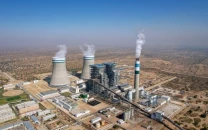LSM sector grows 4.8% in Q1
Rise comes in wake of increased output in food, textile and mineral sectors

Large-scale manufacturing (LSM) industries grew 4.8% in the first quarter of current fiscal year on the back of increased output in food, textile and mineral sectors, reported the Pakistan Bureau of Statistics (PBS) on Thursday.
The cumulative expansion in the first three months (July-September) of current fiscal year came in at 4.8%, reported the national data collecting agency.
The 4.8% quarterly growth rate is better than government’s expectations and gives a ray of hope for the revival of economic activities. However, October’s reading will be crucial to see whether the momentum continues under the second wave of Covid-19 disease in Pakistan.
Out of 15 major industries, nine saw a surge in production while output of five industries showed contraction in the first quarter compared to the same period of previous fiscal year, according to the PBS.
The government expects a 2.5% contraction in the LSM sector in the current fiscal year, according to the Annual Plan 2020-21, released by the Ministry of Planning and Development on the eve of federal budget.
LSM recorded 7.7% year-on-year growth in September, which kept hopes alive for a recovery after the large industrial sector contracted more than 10% in the previous fiscal year.
On a month-on-month basis, the LSM sector showed 10% growth in September over August.
The industrial sector has a major contribution to the tax collection and the sector’s share in revenues is almost triple than its contribution to the overall economic output. The Federal Board of Revenue (FBR) had collected Rs1.01 trillion in taxes in the first quarter with a growth rate of only 4%.
The Ministry of Finance has so far given mixed signals of economic recovery and has not yet taken a definite position on whether the country is out of the recession phase. If the LSM trend continues, it will help to close the current fiscal year near the annual economic growth target after better output of some major crops.
For the current fiscal year, the federal government has set the economic growth target at 2.1%, which will be better in the current overall economic situation but is not enough to create jobs for a growing population.
Prime Minister Imran Khan won the July 2018 elections on the promise of creating 10 million jobs and constructing five million homes at affordable prices but the promises have remain unfulfilled so far. With the current sluggish economic growth, there will be increase in poverty and unemployment in the remaining tenure of the government.
Data collected by the Oil Companies Advisory Committee (OCAC) showed that 11 types of industries registered an average 0.2% growth in the first quarter of current fiscal year. Production of jet fuel declined almost 43%, diesel oil 62% and lubricating oil 40%.
However, the production of kerosene oil increased 36%, motor spirit 18% and high-speed diesel one-tenth in the first quarter.
The Ministry of Industries, which monitors 15 industries, reported 3% growth in the LSM output. Provincial bureaus reported a growth of 1.7% in 11 industries.
Sectors that posted growth on a quarterly basis included textile that grew 2.1% and non-metallic mineral products that increased 22.2% during the July-September period.
But the output of power looms declined 50% in the first quarter, contrary to the media hype generated around utilisation of power looms at full capacity.
The fertiliser sector showed 2.1% growth whereas the food, beverages and tobacco group recorded 13% growth in the first quarter.
The manufacturing of chemical products increased almost 10%, paper and board 10.4% and rubber products 8.2%. The pharmaceutical sector registered a growth rate of 13.4% in the July-September period. The coke and petroleum sector output increased 2.7%.
Industries that registered a dip in manufacturing included the automobile sector, which saw a contraction of 5.4% in the first quarter. Iron and steel production fell 8.1%, electronics 20.7%, leather products 45%, engineering products 37% and wood products 70% in the first quarter.
Published in The Express Tribune, November 13th, 2020.
Like Business on Facebook, follow @TribuneBiz on Twitter to stay informed and join in the conversation.



















COMMENTS
Comments are moderated and generally will be posted if they are on-topic and not abusive.
For more information, please see our Comments FAQ